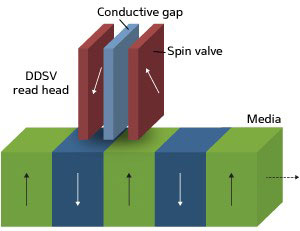| Posted: Sep 29, 2010 |
|
Applied physics: A head-to-head comparison
|
|
(Nanowerk News) To keep up with market demand, the technology roadmap has the areal density of hard disk drives (HDDs) reaching ten terabits per square inch (Tb/in2) by around 2015. Increasing the areal density to such levels requires the magnetic domains for storing data to be made extremely small, with an equally small but sensitive read head for reading the data.
|
 |
| Fig. 1: Simplified schematic illustration of a read head based on a differential dual spin valve (DDSV)
|
|
Many manufacturers have used 'spin valves' for reading data at high densities. The read heads in such systems consist of multilayered sensors that exploit the giant magnetoresistance (GMR) effect to detect extremely weak magnetic fields. When the spin valve passes over a magnetic domain, the magnetization of one of the sensor layers (the 'free' layer) rotates, generating a dramatic change in electrical resistance, or GMR, that can easily be measured.
|
|
Unfortunately, the magnetization in the sensor's reference or 'pinned' layer is prone to noise from adjacent magnetic domains. Manufacturers have improved the magnetic stability of these read head by replacing the pinned layer with a synthetic antiferromagnetic (SAF) structure and embedding the spin valve sensor between two magnetic shields. However, the SAF structure occupies a large portion of the spin valve's total thickness and manufacturers have difficulty reducing this thickness below 20 nanometers.
|
|
Gu Chang Han and co-workers at the A*STAR Data Storage Institute have now explored the feasibility of using differential dual spin valves (DDSV) in ultrahigh-density (>10 Tb/in2) HDDs ("A differential dual spin valve with high pinning stability"). A DDSV, essentially two spin valves separated by a conductive gap layer, only responds to a localized field transition and therefore requires no magnetic shield to filter out noise.
|
|
The researchers fabricated two DDSVs for comparison. One DDSV, called DDSV-A, comprised a simple spin valve, a conductive gap layer and a spin valve with an SAF structure. Another DDSV, called DDSV-B, comprised a spin valve with an SAF structure, a conductive gap layer and a spin valve with a double SAF structure.
|
|
The researchers measured the electrical resistance of both DDSVs as a function of magnetic field and found DDSV-B to have a higher pinning field with higher magnetic stability. As no magnetic shield is required for filtering out noise, the reading resolution of the DDSV is limited only by the thickness of the gap layer and free layers — typically just several nanometers. "The DDSV allows higher reading resolution, which enables more data to be crammed into HDDs," says Han.
|

